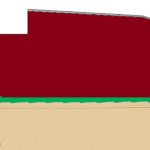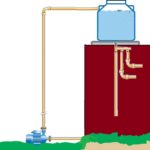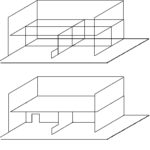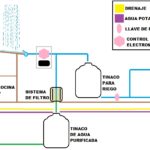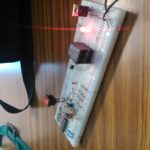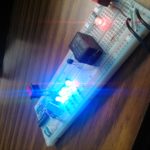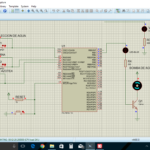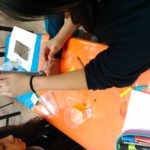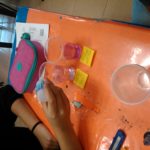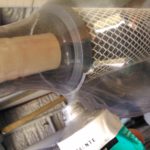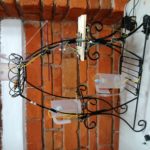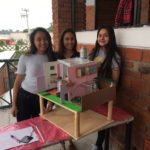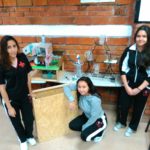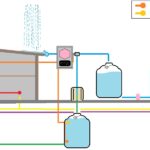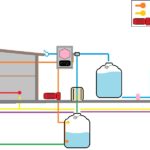RECICLAJE DE AGUA
RECICLAJE DE AGUA
Categoría: Medio Superior (Preparatoria)
Área de participación: Medio Ambiente
Resumen
- Plantear la propuesta a dar para apoyar a la sociedad.
- Decidir el planteamiento del problema, la hipótesis y el objetivo.
- Diseñar la propuestas físicas en papel.
- Elegir materiales viables para desarrollar una maqueta.
- Investigar formas de captar agua de lluvia, tipos de limpiar agua de lluvia y forma de distribuir el agua por toda la casa.
- Diseñar la forma de captar el agua.
- Diseñar el sistema hidráulico que distribuye el agua por toda la casa.
- Captar agua de lluvia de varias zonas geográficas.
- utilizar purificador para comprobar si se limpia el agua de lluvia captada.
- Construir la maqueta.
- Diseñar circuito electrónico que controle el sistema hidráulico.
- Apoyados de la universidad ITTLA con un asesor, entregar especificaciones para construir prototipo electrónico.
- Analizar resultados.
- Concluir.
Pregunta de Investigación
¿Se podrá captar agua de lluvia para ser utilizada para uso doméstico de forma limpia?Planteamiento del Problema
Lograr que el agua utilizada en un hogar sea menor a lo común, utilizando la sustentabilidad de la lluvia, por medio de la tecnología e ingeniería aplicada en un sistema hidráulico.
Antecedentes
Una de las formas más fáciles y eficaces de reciclaje de agua, es recuperar el agua de la lluvia. Es importante decir, que estas aguas que podemos recuperar, no son aptas para el consumo humano si no la potabilizamos, pero sí perfectamente útiles para regar, la limpieza del hogar y otro tipo de tareas que requieren agua.
Para ello, la opción más común es la de instalar un tinaco, que sirva de depósito para el agua. El agua suele recuperarse en los techos de las casas y mediante una serie de canalizaciones que lleva el agua hasta el depósito. Una vez allí y con la ayuda de un mecanismo de extracción, como puede ser una bomba, podríamos utilizarla. Esta práctica es bastante común en chalets y fincas rurales, significa un ahorro importante de agua en riegos de los jardines y plantas.
El sistema que utilizaremos será controlado por electro-niveles que serán colocados dentro de los tinacos y que indicarán el nivel del agua dentro de los mismos, de ésta forma una bomba hará llegar el agua del tinaco en el que se almacena el agua hacia el tinaco principal que a su vez llevará el agua al resto de la casa por tuberías para su uso doméstico.
Objetivo
El objetivo de este proyecto es mostrar de forma clara un proceso de reciclaje de agua de lluvia en una casa común y su uso, controlado por un sistema electrónico para la comodidad calidad y seguridad del mismo.
Justificación
Al ver la cantidad de agua de lluvia que nuestra región maneja en diferentes estaciones climáticas, nos generó la inquietud de poder utilizarla para sustituirla de la que se suministra diariamente a las casas por medio del sistema de aguas potables, considerando que esta agua es tratada desde los mares o ríos, consideramos que es gran ayuda al ahorro económico en gasto de uso de agua para un hogar, así como la utilidad en el mismo. Esto es poder tener un suministro extra del agua como la que genera naturalmente el planeta por la lluvia, además del servicio básico de suministro de agua potable.
Hipótesis
Si se controla la captación de agua de lluvia, su canalización y filtrado mediante un sistema electrónico, se podrá emplear para el uso doméstico de forma eficaz y cómoda.
Método (materiales y procedimiento)
Primero investigamos sobre la forma de purificar o limpiar el agua de lluvia para uso doméstico común, no para beber sino para uso de drenaje o lavado de artículo, de igual forma investigar la forma de cómo podríamos controlar la captación de agua de lluvia.
Posteriormente nosotras creamos un prototipo del sistema hidráulico sobre una maqueta en donde se puede ver el procedimiento que queremos que suceda recolectando agua de lluvia y tenerla como un tinaco de repuesto.
El material que usamos para la maqueta fueron dos tablas de 60×45 de 1.5 cm, cilindros de madera para el soporte entre las dos, un tinaco en la parte inferior, posterior y uno en el jardín que es el que va a ayudar al sistema de riego, tablas de madera más delgadas para las separaciones de la casa, para las tuberías usamos lazo de goma intravenosa, cajas para el filtro, foami de diferentes colores, silicón, pinturas, etc.
Se hacen pruebas con el filtro de agua al recolectarla de la lluvia, utilizamos una jeringa para inyectar el agua de lluvia directo al filtro y por la presión de salida del agua de la jeringa se logra tener la fuerza suficiente para ser filtrada, con gotas que determinan que tan pura es el agua logramos comprobar su purificación.
Al tener los resultados se puede desarrollar una maqueta de forma de prototipo de cómo funciona el sistema de purificación.
Con ayuda de asesores del Instituto Tecnológico de Tlalnepantla, desarrollaron el circuito eléctrico que controla el sistema hidráulico, bajo nuestras especificaciones, este se conforma por un circuito de prototipo con indicadores de luz led para mostrar cómo se controlaría el sistema de riego y uso de llenado de tinaco principal de la casa.
Al tener calculado y simulado el sistema electrónico, con ayuda de asesores universitarios se desarrolla el sistema hidráulico controlado por micro-controladores que permiten ver la forma que se distribuye el agua por cada uno de los tinacos.
Resultados
- Se determinó que el agua de lluvia se puede captar por medio de un sobre-techo de acrílico que permite tener mayor superficie para tener mayor captación de agua.
- Al contener agua de lluvia, por medio de filtro de carbón activado, comprobamos que se purifica por medio de uso de gotas que determinan la purificación de la misma.
- Se desarrolló el prototipo del sistema de filtro para purificar el agua.
- Este prototipo, fue robado en la exposición de la feria de ciencias y tecnología, por lo que a continuación, se muestra el nuevo que se desarrolló.
- Se desarrolló el diagrama del sistema hidráulico con las ubicaciones de los tinacos, uno abajo del suelo y el otro a nivel de suelo.
- Se construyó la maqueta del sistema hidráulico.
- Se desarrolló un circuito electrónico, que permite interpretar y simular el control electrónico del sistema hidráulico, este funciona de manera manual.Se determina que la maqueta debe tener el sistema de recolección de agua con mayor superficie, por lo que se coloca el sobre techo de acrílico.
- Al entregar la idea a los asesores universitarios, en varios meses, se logra desarrollar el prototipo del sistema hidráulico. Primero se simulo en software y se determinaron los cálculos para desarrollar la programación del micro-controlador.
- El código de programación se desarrolla.
- Se construyó y armaron los dispositivos electrónicos que forman el prototipo del sistema hidráulico, sustituyendo tinacos por recipiente de plástico, la tubería de plástico y el circuito programado real.
- Se hicieron pruebas para su uso, y solo por protección, se desarrolla una caja de madera para poder transportarla y tener firme.
- Desarrollamos un vídeo para tener evidencia de funcionalidad.
Discusión
Estamos contentas con nuestro proyecto, porque fue posible cumplir con el objetivo, nos dimos cuenta que realmente si se puede purificar el agua de lluvia sin mucha tecnología y que con ayuda de elementos y dispositivos electrónicos, se logró controlar un proceso.
También, la interacción de poder trabajar con universitarios en la carrera de macatrónica, fue muy interesante y muy aprovechable por lo que aprendimos, al visitar la universidad y conocer un laboratorio de electrónica y todo lo que se debe considerar para desarrollar un simple circuito es mucho aprendizaje y conocimiento, pero a pesar de nuestro nivel medio superior, logramos entender la funcionalidad y composición de los mismos, encontrar los componentes a escala fue complicado, pero con ingenio se logran suplir por elementos accesibles en costos y funcionalidad.
Consideramos que la próxima etapa a desarrollar es sobre la aplicación en una casa habitación, así determinar costos reales y la eficiencia de los elementos y dispositivos que conforman el sistema.
Conclusiones
Obtuvimos la captación de agua por medio de un sobre-techo con características que permite manipular el agua de lluvia, sin obstáculos. El agua de lluvia se logra limpiar por medio de un sistema de purificación, con filtros de carbón activado, el cual contiene millones de agujeros microscópicos que capturan y rompen las moléculas de los contaminantes y es muy eficiente para eliminar el cloro, el mal olor, los sabores desagradables y los sólidos pesados en el agua, así como retener algunos contaminantes orgánicos, como insecticidas, pesticidas y herbicidas.
Se logró diseñar y construir el prototipo que explica cómo funciona la distribución de agua entre los tinacos de una casa, estos controlados por micro-controladores que por medio de electro-niveles dan la funcionalidad real de como automáticamente se puede llenar un tinaco de agua.
Determinamos que el sistema no solo funciona por energía eléctrica como fuente de suministro, ya que si no hay luz, entonces se puede manipular el sistema hidráulico de manera manual y así seguir utilizado el agua en tinacos.
Bibliografía
Béjar,F. (Octubre 9, 2015). Reciclaje del agua. Diciembre 1, 2016, de Sano y ecológico Sitio web: http://sanoyecologico.es/reciclaje-del-agua/
Anónimo. (Abril 12, 2016). Reciclaje del agua. diciembre 1, 2016, de inforeciclaje Sitio web: http://www.inforeciclaje.com/reciclaje-agua.php
Fontaine,R. (2016 ). Reciclaje de agua. Agosto 2 ,2016 de 3 Columbus Circle, 15th Floor New York, NY 10019 USA Sitio web: https://www.rwlwater.com/reciclaje-agua/?lang=es
Marqués de Leganés.. Ecologismo social. 2017, de Ecologistas en acción Sitio web: https://www.ecologistasenaccion.org/
Anónimo. (2017). Ecología y reciclaje. 2017, de twenergy Sitio web: https://twenergy.com/
RECICLAJE DE AGUA
RECICLAJE DE AGUA
Summary
-To propose the proposal to give to support the society.
-Decide the problem approach, the hypothesis and the objective.
-Design physical proposals on paper.
-Choose viable materials to develop a model.
-Investigate ways to capture rainwater, types of rainwater cleaning and how to distribute water throughout the house.
-Design the way to capture the water.
-Design the hydraulic system that distributes water throughout the house.
-Capture rainwater from several geographical areas.
-Use a purifier to check if the rainwater collected is cleaned.
-Build the model.
-Design electronic circuit that controls the hydraulic system.
-Supported by ITTLA University with a consultant, provide specifications to build electronic prototype.
-Analyze results.
-Conclude.
Research Question
Can rainwater be collected to be used for clean domestic use?Problem approach
To make water used in a household less common, using rain sustainability, through the technology and engineering applied in a hydraulic system.
Background
One of the easiest and most effective ways to recycle water is to get rainwater back. It is important to say that these waters that we can recover are not suitable for human consumption if we do not drink water, but are perfectly useful for watering, cleaning the house and other tasks that require water.
For this, the most common option is to install a water tank, which serves as a reservoir for water. The water is usually recovered in the roofs of houses and through a series of pipes that carries the water to the reservoir. Once there and with the help of an extraction mechanism, such as a pump, we could use it. This practice is quite common in rural houses and farms, it means a significant saving of water in irrigation of gardens and plants.
The system that will be used will be controlled by electro-levels that will be placed inside the tinacos and that will indicate the level of the water inside them, of this form a pump will arrive the water of the water tank in which the water is stored towards the tinaco main that in turn will take the water to the rest of the house by pipes for its domestic use.
Objective
The objective of this project is to clearly show a process of recycling rainwater in a common house and its use, controlled by an electronic system for comfort quality and safety.
Justification
When we see the amount of rainwater that our region handles in different climatic seasons, we were worried that it could be used to replace it with the daily supply to the houses through the potable water system, considering that this water is treated from the seas or rivers, we consider that it is great help to the economic saving in the expense of use of water for a home, as well as the utility in the same. This is to be able to have an extra supply of water like the one that naturally generates the planet by the rain, in addition to the basic service of potable water supply.
Hypothesis
If you control rainwater collection, channeling and filtering by an electronic system, it can be used effectively and comfortably for home use.
Method (materials and procedure)
We first investigate how to purify or clean rainwater for common domestic use, not to drink but to use drainage or washing of the article, as well as investigating how we could control the collection of rainwater.
Later we create a prototype of the hydraulic system on a model where you can see the procedure that we want to happen by collecting rainwater and have it as a spare water.
The material we used for the model were two boards of 60×45 of 1.5 cm, wooden cylinders for the support between the two, a water tank at the bottom, back and one in the garden that is the one that will help the irrigation system , thinner wooden boards for house separations, for pipes we use intravenous rubber loop, filter boxes, foami of different colors, silicone, paints, etc.
We use a syringe to inject the rainwater directly into the filter and the water pressure of the syringe is sufficient to be filtered, with drops that they determine how pure the water is to verify its purification.
By having the results you can develop a mock-up prototype of how the purification system works.
With the help of consultants of the Technological Institute of Tlalnepantla, they developed the electrical circuit that controls the hydraulic system, according to our specifications, this is formed by a prototype circuit with led indicators to show how the irrigation system and filling use would be controlled of main house water.
When the electronic system has been calculated and simulated, with the help of university advisors, the hydraulic system is developed controlled by micro-controllers that allow to see the way the water is distributed by each of the water tanks.
Method Gallery
Results
It was determined that the rainwater can be captured by means of an acrylic over-roof that allows to have a larger surface to have a greater water uptake.
When it contains rainwater, by means of activated carbon filter, we verify that it is purified by means of drops that determine the purification of the same.
The prototype of the filter system was developed to purify the water.
This prototype was stolen in the exhibition of the science and technology fair, so that the next one is shown that was developed.
The diagram of the hydraulic system was developed with the locations of the water tanks, one below the ground and the other at ground level.
The model of the hydraulic system was constructed.
An electronic circuit was developed, which allows to interpret and simulate the electronic control of the hydraulic system, this operates manually.
It is determined that the model must have the system of collection of water with greater surface, reason why the acrylic ceiling envelope is placed.
When delivering the idea to the university advisors, in several months, it is possible to develop the prototype of the hydraulic system. First it was simulated in software and the calculations were determined to develop the programming of the micro-controller.
The programming code is developed.
The electronic devices that form the prototype of the hydraulic system were built and assembled, replacing tin cans with plastic containers, plastic pipes and the actual programmed circuit.
They were tested for use, and only for protection, a wooden box is developed to be able to carry it and to have it firm.
We developed a video to have evidence of functionality.
Results Gallery
Discussion
We are happy with our project, because it was possible to meet the objective, we realized that really if you can purify rainwater without much technology and that with the help of electronic elements and devices, you managed to control a process.
Also, the interaction of being able to work with university students in the course of macatronics was very interesting and very useful for what we learned, when visiting the university and knowing an electronics laboratory and everything that should be considered to develop a simple circuit is a lot learning and knowledge, but despite our higher average level, we managed to understand the functionality and composition of the same, finding the components to scale was complicated, but ingeniously manage to supply elements accessible in cost and functionality.
We consider that the next stage to be developed is about the application in a house room, thus determining real costs and the efficiency of the elements and devices that make up the system.
Conclusions
We obtained the water collection through an over-roof with characteristics that allows to manipulate the rainwater, without obstacles. Rainwater can be cleaned by means of a purification system, with activated carbon filters, which contains millions of microscopic holes that capture and break down the molecules of pollutants and is very efficient to eliminate chlorine, bad smell, unpleasant flavors and heavy solids in the water, as well as retaining some organic contaminants such as insecticides, pesticides and herbicides.
It was possible to design and construct the prototype that explains how the water distribution between the tinacos of a house, these controlled by micro-controllers that by means of electro-levels give the real functionality of how automatically can fill a water tank.
We determine that the system not only works by electric power as a source of supply, since if there is no light, then the hydraulic system can be handled manually and thus the water in the water can be used.
Bibliography
Béjar, F. (October 9, 2015). Recycling of water. December 1, 2016, from Sano and ecológico Website: http://sanoyecologico.es/reciclaje-del-agua/
Anonymous. (April 12, 2016). Recycling of water. December 1, 2016, de inforeciclaje Website: http://www.inforeciclaje.com/reciclaje-agua.php
Fontaine, R. (2016). Recycling of water. August 2, 2016 of 3 Columbus Circle, 15th Floor New York, NY 10019 USA Website: https://www.rwlwater.com/recycling-water/?lang=en
Marqués de Leganés .. Social ecology. 2017, of Ecologists in action Website: https://www.ecologistasenaccion.org/
Anonymous. (2017). Ecology and recycling. 2017, from twenergy Website: https://twenergy.com/


